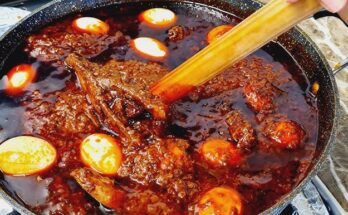Cabbage Casserole Recipe: There’s something incredibly heartwarming about a good casserole. And if you’re looking for a dish that’s as easy to make as it is satisfying, the cabbage casserole should be your go-to comfort food. Packed with rich flavors, textures, and a wholesome blend of ingredients, this humble dish transforms the simple cabbage into a star of the dinner table. Whether you’re feeding a hungry family or meal-prepping for the week, this guide will take you through every step to make the perfect cabbage casserole.
What is Cabbage Casserole?
Cabbage casserole is a baked dish made with layers of cabbage, meats or meat substitutes, seasonings, and often a creamy or cheesy sauce. It brings together the soft, tender texture of cooked cabbage with the hearty goodness of ground beef or turkey, rice or noodles, and a variety of spices. Unlike stuffed cabbage rolls, which require rolling and individual assembly, this casserole version simplifies things without compromising on taste.
At its core, cabbage casserole is a “dump and bake” kind of recipe—great for busy nights when you need something hearty, warm, and deeply satisfying. Whether you’re going traditional with tomato sauce and ground beef or opting for a vegetarian version with lentils and mushrooms, there’s endless room for creativity.
Why Cabbage Casserole is a Comfort Food Staple
There’s a reason casseroles are mainstays in many households. They’re versatile, affordable, and easy to make in large batches. Cabbage casserole, in particular, holds a special place because of its rich flavors, high nutritional value, and the fact that it’s incredibly forgiving. Even beginner cooks can whip this up with minimal effort.
Cabbage itself is loaded with fiber, vitamins C and K, and is low in calories—making this a relatively healthy indulgence when balanced with lean proteins and whole grains. Plus, it reheats beautifully, making leftovers just as tasty (if not more) than the day it was made.
Ingredients You’ll Need
Fresh Produce and Vegetables
The foundation of any great cabbage casserole starts with fresh, quality vegetables. Here’s what you’ll typically need:
- 1 medium head of green cabbage (about 2 to 3 lbs), chopped or shredded
- 1 onion, finely chopped
- 2-3 cloves of garlic, minced
- Optional: diced carrots, celery, or bell peppers for added texture and flavor
Green cabbage is most commonly used due to its mild flavor and texture, but you can experiment with savoy or even red cabbage for a twist.
Proteins and Optional Add-Ins
To make this casserole a full meal, most recipes include a protein:
- 1 lb ground beef or ground turkey
- Vegetarian alternative: lentils, tofu, or meat substitutes like Beyond Meat
- 1 cup cooked rice or egg noodles (optional but adds heartiness)
- Optional add-ins: bacon bits, sausage, or even a cracked egg baked on top for a brunchy vibe
Adding cheese can take the casserole to the next level. Mozzarella, cheddar, or a blend of cheeses work wonders when melted over the top or mixed in for a gooey texture.
Pantry Staples and Seasonings
Every great casserole relies on flavor-enhancing pantry staples. Keep these items handy:
- 1 can diced tomatoes or tomato sauce (15 oz)
- 1 tablespoon tomato paste for richness
- 1 teaspoon paprika
- Salt and pepper to taste
- Optional: red pepper flakes for a kick
- Olive oil or butter for sautéing
Some like to add a bit of broth (chicken or vegetable) to keep the casserole moist during baking.
Equipment Required
Basic Kitchen Tools
You won’t need fancy gadgets, but having these will make your job easier:
- A large skillet or sauté pan
- Sharp kitchen knife and cutting board
- Mixing bowls
- Wooden spoon or spatula
A good, sharp knife is particularly important for breaking down the cabbage quickly and safely.
Ideal Baking Dish Types
You’ll need a sturdy baking dish for the casserole. Depending on your batch size:
- 9×13 inch baking dish (for larger servings)
- 8×8 inch dish (for smaller portions or trial batches)
- Casserole dish with a lid (optional but helps retain moisture)
Make sure to grease the dish before layering to prevent sticking and make cleanup a breeze.
Preparing Your Ingredients
How to Chop and Prepare Cabbage
Prepping your cabbage is key. Start by removing any damaged or wilted outer leaves. Cut the cabbage into quarters and remove the core from each section. You can then either shred it thinly with a knife or roughly chop it into bite-sized pieces depending on your texture preference.
Once chopped, rinse under cold water to remove any residual dirt. Some cooks like to parboil or steam the cabbage briefly before assembling the casserole to soften it up—especially if using thick pieces.
Prepping Proteins and Other Veggies
For meat-based casseroles, brown your ground beef or turkey in a skillet with a touch of oil. Add chopped onions and garlic to the meat as it cooks, letting the flavors meld. Drain excess fat to keep the dish from becoming greasy.
If using lentils or tofu, cook them separately with similar seasonings. For veggies like carrots or bell peppers, a quick sauté softens them and enhances their sweetness, which pairs beautifully with the cabbage and tomato base.
Step-by-Step Cabbage Casserole Recipe
Step 1: Preheat and Prep
Before diving into the cooking process, it’s essential to set the stage for a seamless experience. Begin by preheating your oven to 350°F (175°C). This ensures that the oven reaches the desired temperature by the time you’re ready to bake, allowing for even cooking.
Next, prepare your baking dish. A 9×13-inch casserole dish is ideal for this recipe. Lightly grease it with butter or non-stick cooking spray to prevent sticking and make cleanup easier.
Now, focus on your ingredients. Chop the cabbage into bite-sized pieces, ensuring uniformity for consistent cooking. Dice the onion finely, and if you’re adding other vegetables like bell peppers or carrots, prepare them accordingly. Grate your cheese and set aside the required amount for both the filling and topping.
Organizing your ingredients beforehand, often referred to as “mise en place,” streamlines the cooking process and minimizes the chances of missing any components.
Step 2: Cook the Filling
In a large skillet over medium heat, melt a tablespoon of butter or heat a splash of olive oil. Add the diced onions and sauté until translucent, about 3-4 minutes. If you’re incorporating other vegetables, add them now and cook until they begin to soften.
Introduce the chopped cabbage to the skillet. Season with salt, pepper, and any additional spices you prefer, such as paprika or garlic powder. Stir well to combine all the ingredients. Cook the mixture, stirring occasionally, until the cabbage wilts and reduces in volume, approximately 8-10 minutes.
If you’re adding a protein like ground beef or turkey, cook it separately until browned and fully cooked. Drain any excess fat and mix it into the cabbage mixture. This step ensures that the meat is thoroughly cooked and integrates well with the vegetables.
Once the filling is ready, remove the skillet from heat and let it cool slightly. This pause allows the flavors to meld and prepares the mixture for layering in the casserole dish.
Step 3: Layer and Assemble
With your filling prepared and the oven preheated, it’s time to assemble the casserole. Begin by spreading a thin layer of the cabbage mixture at the bottom of the greased baking dish. This base layer ensures that the flavors are evenly distributed throughout the casserole.
If you’re using a creamy component like a mixture of cream of mushroom soup and mayonnaise, spread a portion over the cabbage layer. This adds richness and moisture to the dish.
Continue layering the cabbage mixture and creamy sauce alternately until all the ingredients are used, finishing with a layer of the creamy sauce on top.
For the topping, combine crushed Ritz crackers with melted butter and shredded cheddar cheese. Sprinkle this mixture evenly over the top layer. The topping adds a delightful crunch and cheesy finish to the casserole.
Step 4: Bake to Perfection
Place the assembled casserole in the preheated oven and bake for 30-45 minutes, or until the top is golden brown and the casserole is bubbling around the edges. The exact baking time may vary depending on your oven and the depth of the casserole dish.
To ensure even cooking, rotate the dish halfway through the baking time. This step promotes uniform browning and prevents any hot spots from overcooking certain areas.
Once baked, remove the casserole from the oven and let it rest for about 10 minutes. This resting period allows the casserole to set, making it easier to slice and serve.
Step 5: Let it Rest and Serve
After the resting period, your cabbage casserole is ready to be served. Use a sharp knife to cut into portions, and a spatula to transfer the servings to plates. The casserole pairs wonderfully with a simple side salad or crusty bread.
Leftovers can be stored in an airtight container in the refrigerator for up to 3 days. Reheat individual portions in the microwave or warm the entire casserole in the oven at 350°F (175°C) until heated through.
Tips for Making the Best Cabbage Casserole
Flavor Enhancers and Variations
One of the great things about cabbage casserole is how easily customizable it is. The base recipe provides a solid foundation, but with a little creativity, you can adapt it to suit your taste buds perfectly.
To enhance the flavor profile, consider these additions:
- Spices & Herbs: Thyme, oregano, and bay leaves add an earthy depth. For a smoky touch, a dash of smoked paprika works wonders.
- Umami Boosters: A spoonful of Worcestershire sauce, soy sauce, or a sprinkle of nutritional yeast can enhance the savory profile.
- Heat: If you like a kick, add cayenne pepper or chopped jalapeños to the filling.
- Acid Balance: A splash of apple cider vinegar or lemon juice brightens up the richness of the casserole.
Want to explore different cultural twists?
- Italian-style: Swap out cheddar for mozzarella, add marinara sauce, and layer with cooked pasta instead of rice.
- Mexican-inspired: Use taco seasoning in the beef, add black beans, corn, and top with pepper jack cheese.
- Vegetarian-friendly: Load it with lentils, chickpeas, or quinoa for protein and extra fiber.
This flexibility ensures you never get bored with the same recipe—and it’s a great way to clean out your fridge by using whatever you have on hand.
Common Mistakes to Avoid
Even the simplest recipes can go awry without proper care. Here are some pitfalls to watch out for:
- Underseasoning: Cabbage has a mild flavor, so it needs ample seasoning to bring the dish to life. Taste your filling before baking.
- Overcooking the cabbage: While you want it soft, overcooked cabbage turns mushy and loses its appeal. Cook until just tender before baking.
- Using too much liquid: Watery casseroles can be a problem, especially with added vegetables or sauces. If your filling seems too wet, simmer it a bit longer or add a binder like cooked rice or breadcrumbs.
- Skipping the rest period: Giving the casserole a few minutes to cool after baking is essential. It sets the layers, making it easier to serve and improving texture.
Serving Suggestions
What to Serve with Cabbage Casserole
Cabbage casserole is a meal in itself, but pairing it with the right sides can elevate your dining experience. Here are some great options:
- Crusty Bread: Garlic bread or a rustic sourdough loaf is perfect for scooping up every last bite.
- Fresh Salads: A tangy coleslaw, arugula salad with lemon vinaigrette, or classic garden salad balances the richness of the casserole.
- Roasted Vegetables: Brussels sprouts, green beans, or carrots roasted in olive oil and garlic offer a nutritious and colorful complement.
- Mashed Potatoes: If you’re going all out on comfort food, creamy mashed potatoes are a match made in heaven.
Want to keep it light? Serve smaller portions of the casserole with a generous serving of greens or a light broth-based soup.
Drink Pairings
When it comes to beverages, you have several options that pair beautifully with the dish:
- Red Wine: A medium-bodied red like Merlot or Pinot Noir enhances the casserole’s savory notes.
- Beer: Lager or a light pilsner balances the richness without overpowering the flavors.
- Non-alcoholic: Sparkling water with lemon, ginger ale, or iced tea makes for refreshing non-boozy pairings.
Whether it’s dinner for two or feeding a hungry crowd, you’ll have a complete meal that satisfies everyone.
Make-Ahead and Storage Tips
Can You Make Cabbage Casserole Ahead of Time?
Absolutely! Cabbage casserole is an excellent make-ahead dish, ideal for busy weeknights or meal prep. Here’s how to do it right:
- Prep and Refrigerate: Assemble the casserole completely, cover it with foil or plastic wrap, and refrigerate for up to 24 hours before baking.
- Freeze for Later: Cabbage casserole also freezes well. Prepare it up to the baking stage, wrap tightly in plastic wrap and then foil, and freeze for up to 2 months.
- Bake from Frozen: You can bake it straight from the freezer; just add an extra 15–20 minutes to the baking time, keeping it covered for the first part to prevent the top from burning.
Storage and Reheating Tips
If you have leftovers (lucky you!), store them properly for best results:
- In the Fridge: Store in airtight containers for up to 3–4 days. It reheats beautifully in the microwave or oven.
- In the Freezer: Cool completely, portion into meal-sized servings, and freeze for up to 2 months. Defrost overnight in the fridge or use the defrost function on your microwave.
To reheat, use the oven at 350°F (175°C) until warmed through, or microwave individual portions for 2–3 minutes, covered with a damp paper towel to maintain moisture.
Health Benefits of Cabbage Casserole
Nutritional Value of Cabbage and Key Ingredients
Cabbage might seem like a humble vegetable, but it’s a nutritional powerhouse. Incorporating it into a hearty casserole not only delivers on flavor but also offers numerous health perks.
Here are some key nutritional benefits:
- High in Fiber: Cabbage is rich in dietary fiber, which promotes digestive health and keeps you feeling full longer.
- Low in Calories: This makes it perfect for weight management without compromising on portion size.
- Rich in Antioxidants: Cabbage contains polyphenols and sulfur compounds that reduce inflammation and protect against chronic diseases.
- Vitamins and Minerals: It’s packed with Vitamin C, Vitamin K, folate, calcium, and potassium—all crucial for overall well-being.
When paired with lean proteins like turkey or legumes and whole grains like brown rice, cabbage casserole becomes a well-balanced meal. To keep it healthier:
- Use low-sodium broths and sauces.
- Opt for reduced-fat cheese or skip it altogether.
- Bake instead of frying any components.
Eating well doesn’t mean you have to give up comfort food—and cabbage casserole proves just that.
FAQs about Cabbage Casserole Recipe
Q1. Can I use red cabbage instead of green cabbage?
Yes, you can! Red cabbage adds a pop of color and a slightly earthier flavor. Just keep in mind it might bleed a little color into the dish.
Q2. How do I make cabbage casserole ahead of time?
You can fully assemble the casserole, cover it tightly, and refrigerate it for up to 24 hours before baking. When ready, just pop it in the oven and add 5–10 minutes to the baking time.
Q3. Is cabbage casserole freezer-friendly?
Absolutely! Let it cool completely, wrap it well in foil or airtight containers, and freeze for up to 3 months. Thaw overnight in the fridge before reheating.
Q4. What protein can I add to cabbage casserole?
Ground beef, chicken, turkey, or even sausage works great. Brown it first and mix it into the layers for a hearty twist.
Q5. Can I make it low-carb or keto-friendly?
Yes! Skip any breadcrumbs or starchy fillers. Stick to cheese, cream, and meat for a rich, low-carb version.
Q6. What goes well with cabbage casserole?
It pairs well with crusty bread, roasted potatoes, or a light salad. It’s hearty enough to stand on its own, too.
Q7. Why is my cabbage casserole watery?
Cabbage naturally releases water as it cooks. To reduce moisture, sauté the cabbage before layering or add a sprinkle of breadcrumbs to absorb excess liquid.
Conclusion
If you’re looking for a dish that checks all the boxes—comforting, nutritious, affordable, and easy to make—cabbage casserole should be high on your list. It’s perfect for family dinners, potlucks, or meal prepping your week ahead. With just a few pantry staples and a little creativity, you can whip up a meal that feels like a warm hug in every bite.
From its versatility in ingredients to the heartiness it delivers, cabbage casserole is a reminder that good food doesn’t have to be complicated. So grab that head of cabbage, fire up the oven, and get cooking!



